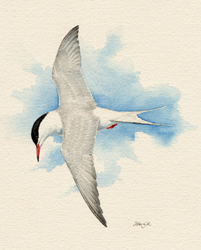Breeding Bird Atlases (BBA)
Find a Bird - BBA1
Breeding Bird Atlas 1 Species Accounts
Common Tern
Sterna hirundo
State Status
Special Concern
Egg Dates
May 4 to August 15
Number of Broods
one; may re-lay if first attempt fails.

The Common Tern breeds on islands and locally on the mainland around the entire coast of Massachusetts and can be seen feeding along most parts of the coast. It has been studied intensively since 1870 and is perhaps the most researched bird in the state. The colony at Muskeget Island was said to contain hundreds of thousands of Common Terns in 1870. However, like most seabirds in the Northeast, Common Terns were almost wiped out by plume hunters and, by 1889, only about 5,000 pairs were left. The population recovered rapidly under protection and reached a peak of 30,000 to 40,000 pairs in the 1920s.
Subsequently, Herring Gulls usurped most of the favored islands for nesting, and Common Terns decreased steadily to about 6,000 pairs in 1977. The population now appears stable at 7,000 pairs, but its status is precarious.
Common Terns start to arrive in late April, and most reach the breeding colonies during May. At this time, small parties of birds migrating to more northern breeding grounds are seen occasionally on lakes and rivers inland. Most birds feed in shallow water close to shore, often in bays, inlets, or tidal creeks. Common Terns characteristically feed in flocks, hovering over schools of fish in shallow water and diving from heights of 10 to 20 feet. Many pick shrimp or insects from the surface of the water. Some birds defend feeding territories along the shore, where they often forage by plunging from perches on docks or boats. Common Terns usually nest on sandy or gravelly islands or on sand dunes on the mainland. They prefer areas that are open enough to provide sitting birds with a clear view but that have enough Dunegrass or other plants to provide shelter for the chicks. A few nest on open sand or on tidal wrack at the edge of salt marshes.
The best-known call is a harsh, descending kee-arrr, used when the terns are alarmed by intruders in the colony or when they are threatening other terns. Feeding and quarreling birds utter a sharp kik, kik, and birds carrying fish use an advertising call, keeur, keeri-keeri-keeri. Male Common Terns carry fish to attract females during aerial courtship display, or later to feed to their mates prior to egg laying. In ground display, assertive birds bend their heads forward, presenting the black cap, while submissive individuals stretch their heads upward and twist their necks to avert the black cap. Common Terns rarely swim except when bathing. Loafing birds collect in flocks on beaches, sand flats, or jetties.
Common Terns lay two or three eggs in a scrape, lined with grasses and shells. Most eggs are laid in the second half of May or early June, but younger birds and birds that have lost early clutches continue to lay until mid-July. Both sexes share the 23- to 27-day incubation period. The young birds are fed in their parents’ territories until they can fly at 22 to 28 days old and for up to two weeks thereafter. Family groups then disperse, but the parents feed the chicks for at least six weeks after fledging. Average fledging success in Massachusetts (late 1960s to early 1980s) was one young per pair. From late July until October, Common Terns disperse widely along the coast, being most numerous on the outer shores of Cape Cod and the Islands.
Common Terns depart from late August to late October; a few stragglers remain into November or even December. Some birds follow the Atlantic Coast south as far as Cape Hatteras, but most banding recoveries in September through November have been in the West Indies. The main winter quarters are along the north coast of South America, extending south to central Peru on the Pacific Coast and to southern Argentina on the Atlantic Coast. Most young birds remain in the winter quarters for 18 months and do not migrate north until the age of two; most do not breed until age three or four. A few banded birds have been retrapped on nests in Massachusetts at ages 20 to 22. Common Terns have been killed for human food in South America, especially in Guyana, and this may have contributed to their recent decline.
The Common Tern is listed as a species of special concern in Massachusetts.
Map Legend and Data Summary
Atlas 1 data collected from 1975-1979


Note: locally common along coast, less numerous north of Boston; population stable at present
Ian C. T. Nisbet



